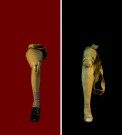MU Researchers Bridging Gap Among the Sciences, Humanities and Society
Program is key component to Mizzou Advantage
January 7th, 2010
COLUMBIA, Mo. — From researchers creating the latest medical devices to scientists uncovering ancient life forms on earth, the pursuit of science is impacted by social networks, societal priorities and research findings themselves. In addition, social scientists, who study society and culture, are being influenced by life science researchers at an increasing rate. Forming connections across academic disciplines is important now more than ever to develop a better understanding of how researchers in the sciences and the humanities can benefit from each other. The Life Sciences & Society Program at the University of Missouri is fostering these connections to help researchers find answers to their questions in ways they never imagined.
“Today’s society is facing profound ethical, legal, economic and policy questions related to many aspects of the life sciences,” said Stefani Engelstein, associate professor of German studies in the College of Arts and Science and director of the MU Life Sciences & Society Program (LSSP) through the MU Bond Life Sciences Center

Patricia Olynyk's prints and installations frequently employ microscopy and biomedical imaging technologies to explore the intersections between art and the life sciences. Olynyk will address this relationship at the upcoming MU Life Sciences & Society Symposium in March.
. “Our mission is to bring researchers from across disciplines and schools in order to develop innovative, multidisciplinary approaches to understanding the interconnections between the sciences and other cultural phenomena.”
As part of the Mizzou Advantage, MU officials are working to create opportunities to network with the most prominent scholars around the world during conferences, bringing them to MU. Through the LSSP, Engelstein is hosting the sixth annual Life Sciences & Society Symposium, which will bring internationally renowned researchers to campus and promote collaboration and productive exchanges with MU faculty. The topic of the symposium, which will be held March 12-14, is From Art to Biology and Back Again. The symposium will feature Daniel Levitin, a neuroscientist who has written a best-selling book, This is Your Brain on Music, and produced 14 gold and platinum albums. From more information on the symposium, visit: http://muconf.missouri.edu/artbiology/index.html
At the symposium, attendees will be treated to lectures from neuroscientists, art historians and anthropologists exploring the neurological and biological contexts of the universal human propensity to create art. Conference attendees also will see presentations from contemporary artists whose work is created using the materials, technologies and artifacts of the biological sciences. One presenter, Eduardo Kac, genetically engineered a glowing rabbit, Alba, which has been the subject of worldwide attention since its birth in 2000.
“We are committed to enhancing our research, teaching and community involvement through productive dialogues that stretch across colleges and beyond the border of the academy,” Engelstein said.

